IP camera powered via ethernet. IP camera power supply – types and features of organization
Network devices differ from other types of cameras, which are only elements of television surveillance systems. Such a device is completely complete and can independently record, digitize, compress and transmit a video signal over the Internet. It can be installed in any desired place and receive an image where it is convenient - for this purpose. As with all complex electronic products, which are subject to strict requirements for operational reliability, uninterrupted power supply to the IP camera is required during operation.
Power supply features of IP cameras (twisted pair, etc.)
Having a high resolution, clarity of video images, these digital devices, and in fact mini-computers with a camera, need to consume significant electrical current. Therefore, the organization of power supply for IP cameras must be approached with all responsibility to eliminate any malfunctions and technical failures.
Types of television surveillance systems
Depending on where the cameras are installed, there are 2 types:
- Video surveillance systems in buildings and premises with heating and lighting systems.
- Video surveillance outside buildings.
Naturally, equipment installed outside consumes a lot of power, which is usually used for IR illumination at night and heating the camera’s thermal casing during low temperatures air. In addition, in both cases, many cameras are equipped with rotating mechanisms with electric drive, motion sensors, which also requires costs.
Types of food
There are 2 power options:
- WITH laying a separate line from external unit power supply with a voltage of 5–24 V or from the built-in 220 V (for cameras for outdoor installation). But you will also need an Internet connection, which is generally reminiscent of double laying the power and coaxial cables to analog cameras.
- IP camera power supply over twisted pair by technology PoE. Only one wire is used to transmit power, video and control the device, which is convenient and practical. The most commonly used wire is 4 twisted pairs.
The big disadvantage is the wire length limitation of 100 m. To overcome this limit, several have been developed technical solutions using additional equipment:
- Using PoE repeaters. Such a device receives power and data flow, then transmits it. A chain of such repeaters connected one after another significantly increases the distance and the ability to power an IP camera via PoE. It is advisable to use high quality cable to reduce losses.
- Installation of converters made using VDSL2 technology. These devices provide power supply up to 1.5 km.
- The use of “PoE Extender” technology, which allows the use of the “Power Reach” device to install cameras up to 500 meters, providing power to both the IP video camera and for power supply to the thermal casing, the use of IR illumination of video surveillance devices outside buildings.
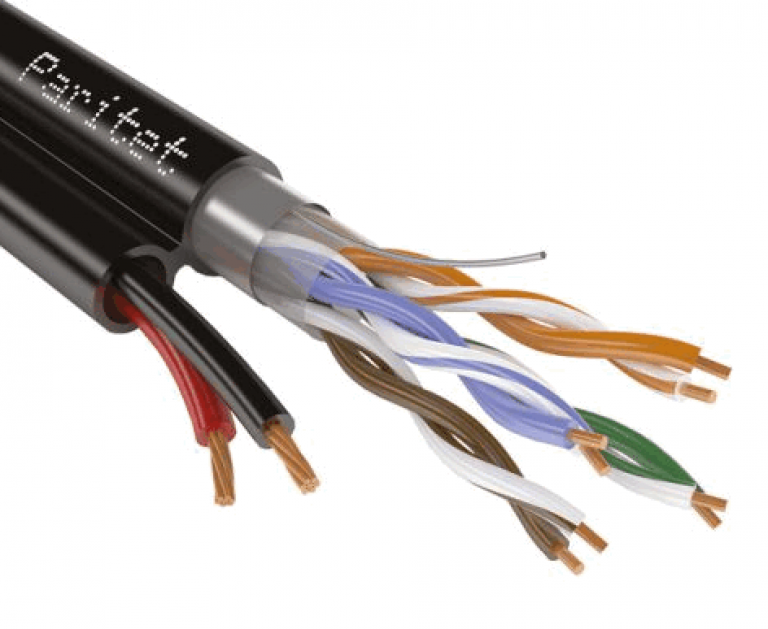 In each specific case, it is necessary to take into account the situation as a whole. Effective choice will be influenced by many factors: availability and ramifications local network, condition and stability of power supply, illumination of premises and territory, climatic conditions, security mode and much more. It is advisable to entrust the development of design and technical solutions to specialists from organizations involved in the design and installation of television surveillance systems.
In each specific case, it is necessary to take into account the situation as a whole. Effective choice will be influenced by many factors: availability and ramifications local network, condition and stability of power supply, illumination of premises and territory, climatic conditions, security mode and much more. It is advisable to entrust the development of design and technical solutions to specialists from organizations involved in the design and installation of television surveillance systems.
This will ultimately make it possible to create a balanced system, where all points of the customer’s technical specifications will be taken into account, including ensuring reliable power supply for IP cameras at a protected facility.
Power supplies
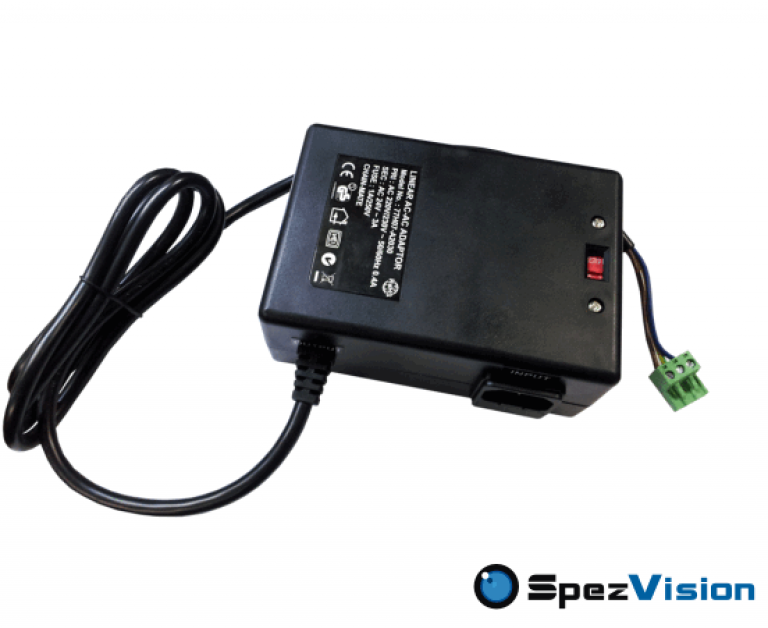 The quality of power supply usually leaves much to be desired. No consumer is immune from sudden power surges or unscheduled outages. That's why right choice equipment is very important, because reliable and long-term operation of any camera directly depends on a stabilized (constant voltage) and continuous power supply. A power supply that is of poor quality or does not meet the technical parameters may well render the camera unusable until it becomes necessary to replace it and render it unsuitable for repair.
The quality of power supply usually leaves much to be desired. No consumer is immune from sudden power surges or unscheduled outages. That's why right choice equipment is very important, because reliable and long-term operation of any camera directly depends on a stabilized (constant voltage) and continuous power supply. A power supply that is of poor quality or does not meet the technical parameters may well render the camera unusable until it becomes necessary to replace it and render it unsuitable for repair.
You can use the power supply for IP cameras that provides the required technical specifications. The following requirements must be taken into account. In addition to the possibility of continuous operation, the power supply must be stabilized and have protection against short circuits and overloads.
Taking into account the inevitable losses, the power supply must provide a 20–30% current reserve to compensate for them.
Powering an IP camera over twisted pair cable makes it much easier to organize power supply redundancy than when using analog video cameras. Enough to connect the block uninterruptible power supply to the PoE switch to which all IP CCTV cameras are connected. This scheme most simply provides reliable uninterrupted power supply. There are switch models with a built-in UPS.
You should not save when purchasing a block, because in addition to providing reliable operation cameras, it itself must be safe and not cause a fire or fire. It is better to purchase equipment from the manufacturer, official dealers or specialized organizations involved in the installation and sale of security system equipment.
Power supply for standalone cameras
In some cases, in the absence of a permanent power supply or temporary unstable power supply to remote or under construction objects, they are used. In such cases, it is necessary to calculate the battery capacity of the power supply to ensure the required operating time. It also makes sense to connect a motion sensor to save energy, which is important if there is no power supply to the facility.
It is best to select a suitable IP camera power supply from the camera manufacturer’s catalog, which will ensure ready-made solution or entrust the selection of appropriate equipment technical specifications specialists.
In conclusion, it should be said that the choice of IP cameras today is quite justified, since technical specifications and technological solutions they are far superior to analog devices. The initial high price of one product pays off due to the absence of many inevitable costs during installation and operation analog systems, and the benefits are undeniable.
August 21, 2013 Options for building IP networks over long distances, organizing power supply for video cameras via PoE
This article will be useful to specialists moving from analogue to digital solutions. For visual perception of the material, some drawings are taken from the Internet.
Despite the simplicity of the IP solutions offered by the market, there are certain requirements when connecting to the Internet - the maximum distance from the data transmission network node to the subscriber device should not exceed 100 m. This condition must be observed when building IP video surveillance networks.
The figure below shows a standard IP system solution that meets the above requirements.
Options for building an IP network
Quite often, when building a network, it becomes necessary to install IP cameras at greater distances from the server and preferably with power supplied to the camera via PoE. To solve these problems, there are three options, each of which will depend on the distance of the video camera:
- the use of additional network components that allow transmitting video images and camera power over a distance of more than 100 m over twisted pair cables;
- laying fiber optic cable;
- use of the existing Internet network.
Let’s make a small digression and take a closer look at PoE technology.
Power over Ethernet - This is a technology for supplying power via Ethernet to network end devices that require both a data link and a power source to operate. It can be network switches Ethernet, wireless access points, IP cameras, etc. The advantage of PoE technology is that it uses only one set of wires for both data transmission and power supply. The current IEEE802.3af standard for powering equipment over Ethernet was officially approved in 2003.

This allows you to reduce installation time and save money on costs. power cables and other components. One of the main features of PoE is the possibility of its use not only when organizing new networks, but also when modifying existing ones. Most often, when upgrading a network, it is necessary to install active end equipment exactly where there is no power source nearby and there is no electrical wiring. Thanks to PoE technology, a WiFi access point, for example, can be installed in places best regards signal, and install the IP camera in any place convenient for viewing.
With the expansion of the use of PoE technology, the need for higher power has constantly increased and several new standards have been approved with different power levels per port: IEEE802.3af (15.4W), IEEE802.3at PoE Plus (30W), Ultra PoE (60-80W) , Mega PoE (95W).
The new IEEE802.3at standard differs from IEEE802.3af in that to increase the power transmitted over the network, two free cable pairs 4-5 and 7-8 are additionally used.
Let's consider several options for building extended networks using additional equipment from various manufacturers:
1. Installation of single-channel repeatersThe maximum segment length in a 100Base-T network is 100 m. A PoE repeater allows you to increase the line length to network end devices by connecting segments in series. The PoE repeater restores the two-way data flow and transmits the power supply to the next device.
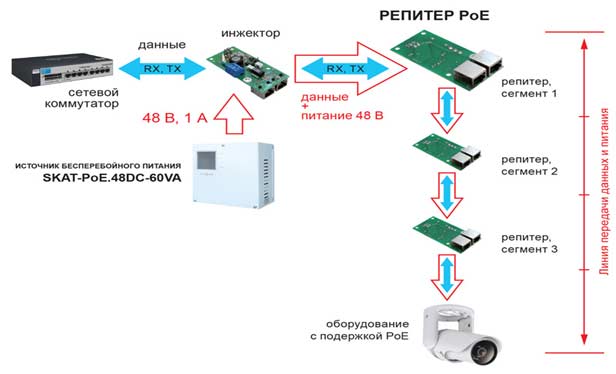
2. The use of single-channel regenerators using technologySHDSL
The IP camera is connected to an information network over a long distance via an SHDSL interface using a regenerator. The line speed reaches 15296 kbit/s over one pair. The camera is powered remotely from the SHDSL module. Up to 3 regenerators can be installed on the line, powered by the SG-17R base platform.

3. Remote connection of an IP camera with remote power supply using PoDSL technology via an SHDSL connection using a regenerator
The IP camera group is connected to the information network via an Ethernet interface. IP cameras have a built-in Ethernet switch for two ports, which allows, in order to optimize cable routing, to organize their connection “in a chain” in transit power mode from one Ethernet port. Maximum amount connected cameras with a segment length between devices of 100 meters - up to 5 pieces.

4. Using devices that are modems/converters made using VDSL2 technology
These products are designed for organizing IP video surveillance systems at remote sites, that is, for transmitting data from IP cameras over distances of more than 100 m via a two-wire copper line (twisted pair) or coaxial cable. The converters have 1 or 4 Ethernet ports for connecting IP cameras and operate at a distance of up to 1.7 km. Often such devices are called Ethernet Extender.
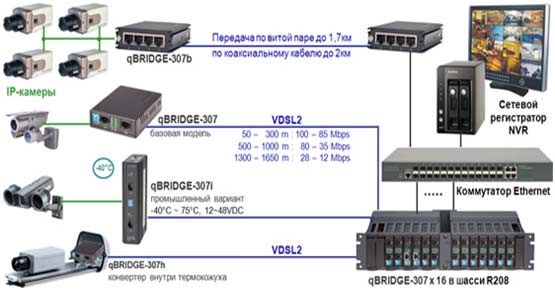
5. Application of 1-channel PoE injectors and splitters with a capacity of 15W
The injector introduces power into the UTP cable, and the splitter selects it and supplies it to the video camera.

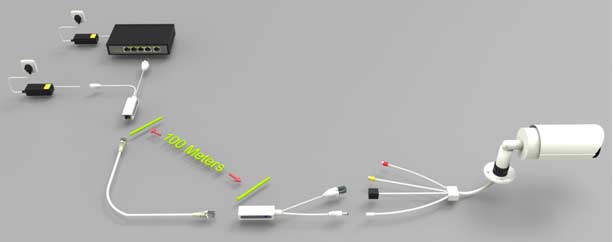
Many POE powered IP cameras already have a built-in splitter.
This simplifies the connection since you only need an injector to connect.
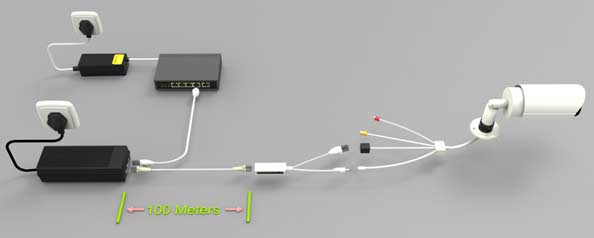
If the power supply is combined with an injector, then to power an IP camera without the PoE function, you only need a splitter.
6. Application of new technology "PoEExtender» allows data and high-power power transmission over ultra-long distances
This function is performed by a product called “Power Reach” or simply a PoE extension cable.
PoE Extender technology is not only compatible with standard Ethernet protocol and IEEE802.3af/at PoE, but also can transmit power up to 60W up to 500m. maintaining a speed of 100 Mbit/s.
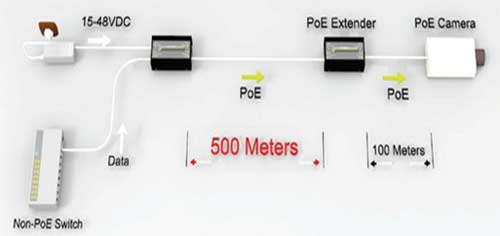
When cascading PoE extenders, you can increase the PoE transmission range to 2 km, but at the same time the power at the end of the line will be 3-5 watts, and the data transfer rate will remain unchanged at 100 Mbit/s.

Option for using PoE extenders when building long-distance networks:
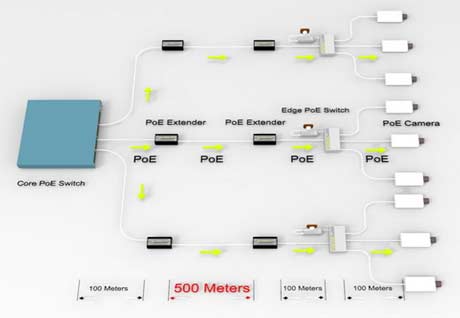
Option to install a PoE extension cable directly into the casing. The resulting power of 60W will be enough to power the video camera, heat the casing, and in some cases, IR illumination.
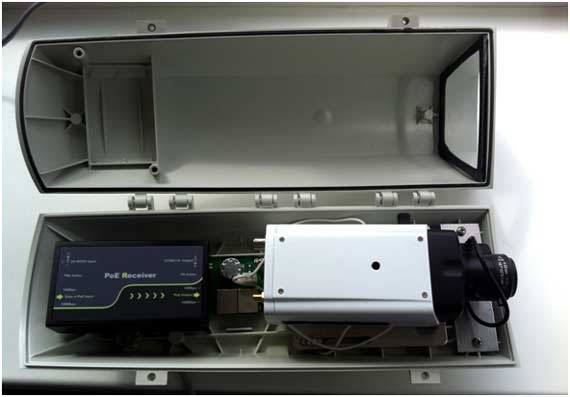
The list of equipment given in the article intended for transmitting video over long distances and powering video cameras via PoE is varied and far from complete. The choice of one or another solution is made by the contractor based on the assigned tasks and his preferences.
Alexander Adushkin
Strict connection to the power grid for a long time was the weak point of the surveillance cameras. Especially at large facilities, where the number of cameras is in the dozens. IP cameras with Power over Ethernet technology do not require a separate power cable - they are powered directly from the network switches to which they are connected. Of course, the switches must be PoE compatible.
Fewer wires, fewer vulnerabilities - less worries when installing and operating the camera. Problems are noticeably simplified backup power. In the event of power surges in the network, UPSs attached to network switches will ensure uninterrupted operation of the entire video surveillance system. That's why more and more businesses are looking to simplify their network infrastructure by using PoE network cameras.
Today, IP cameras of various price categories and areas of use are equipped with PoE technology. Here and inexpensive cameras tracking, such as TrendNet TV-IP512P, and rotating dome cameras HikVision DS-2CD series with resolution up to 5MP. But especially relevant PoE technology for outdoor IP cameras, for example, Axis P1346-E or Axis Q1604-E.
To implement a PoE system in an enterprise, in addition to network surveillance cameras, you will need network switches that support the same technology. This combination will provide guaranteed stable surveillance at critical sites. At the same time, for objects of secondary importance you can always use more budget solutions powered by AC power.
Do you still have questions about the operation of IP cameras with PoE or do you need competent help in selecting a model? Our online consultants are ready to select necessary equipment right now. We will offer an option taking into account your preferences and in the price category you are interested in. If necessary, we can take on all the installation work for a PoE surveillance system at your enterprise.
Poe or Power over Ethernet is a technology that allows you to power network devices, including digital video surveillance cameras, over twisted pair cables. This greatly simplifies the installation of the system.
On the one hand, all cameras have a centralized power supply and this is good in terms of the safety of uninterrupted operation and the absence of interference from third parties, and on the other hand, if the feeding device electricity on the camera (PoE switch) will fail, everything will stop working. But still, my personal opinion is that PoE is a huge plus for network devices.
Not all cameras have the PoE power function, but you can do it yourself. To do this, you need to know what it actually is: Power over Ethernet technology works based on the standard IEEE 802.3af
, which provides a current of up to 400 mA at a voltage of 36 to 57 Volts, this allows you to transmit a current of up to 15 W to the consumer. This standard IEEE 802.3af divides all devices into 5 classes (from zero - the least power consumed by the device, ascending to the fourth, respectively the most powerful)
802.3af PoE-A and PoE-B standards for 100 and 1000 Mbps networks. RJ45 pinout.
| PINS on Switch | 10/100 DC on Spares (Method B) | 10/100 Mixed DC & Data (Method A) | 1000 (1 Gigabit) DC & Bi-Data (Method B) | 1000 (1 Gigabit) DC & Bi-Data (Method A) |
| Pin 1 | Rx+ | Rx+DC+ | TxRx A+ | TxRx A+DC+ |
| Pin 2 | Rx- | Rx - DC + | TxRx A - | TxRx A - DC + |
| Pin 3 | Tx+ | Tx + DC - | TxRxB+ | TxRx B+DC - |
| Pin 4 | DC+ | not used | TxRx C+DC+ | TxRxC+ |
| Pin 5 | DC+ | not used | TxRx C - DC + | TxRx C- |
| Pin 6 | Tx- | Tx - DC - | TxRxB- | TxRx B - DC - |
| Pin 7 | DC- | not used | TxRx D+DC - | TxRxD+ |
| Pin 8 | DC- | not used | TxRx D - DC - | TxRx D- |

Connecting a powered device occurs in several stages:
1. A test is carried out using a device that supplies voltage to connect an IP camera (or other network device) by applying an electrical signal with a voltage of 2.8 to 10 volts and the input resistance is determined, which should be from 19 to 26.5 kOhm
2. Then the class of the IP camera is determined depending on the power it consumes. If the device consumes a current greater than that provided for this class, the power will be turned off.
3. On last stage During the check, full voltage is supplied, but consumption is also monitored here. If digital camera(or other network device) draws less than 5 mA for 400 ms or more than 400 mA for 75 ms, the power will be turned off.
Two power transmission schemes are used for IP cameras via PoE:
In the first case, using two unused pairs of wires of the 5e cat.
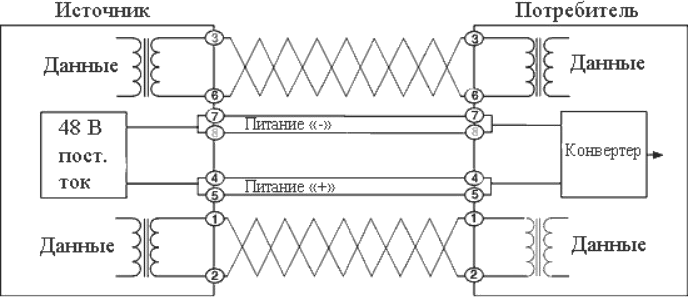
In the second, the current is supplied to the tap of the secondary winding of the source transformer, and is removed from the primary winding of the consumer.

